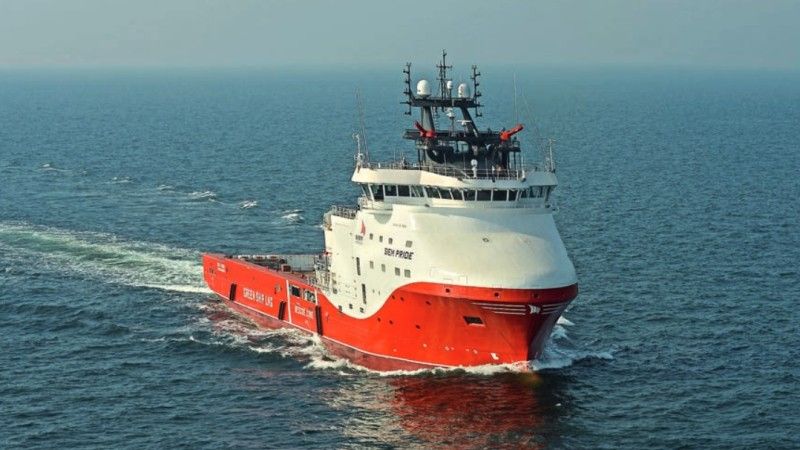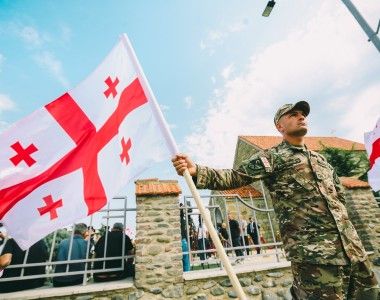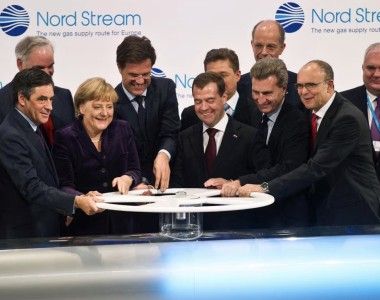Offshore Support Vessels and Poland’s Energy Security

Photo. Remontowa Shipbuilding
Offshore vessels shall be built by the Polish shipbuilding industry. Not only should this be done to autonomously secure the operations of the Polish wind farms, but also to protect the wind farms per se. The offshore vessels could thus be procured by the Polish Navy as well, tasking them with a broad mission set, in the case of which it is less than cost-effective, or even impossible to employ the Kormoran II MCMVs, or the Miecznik frigates in the future.
Pursuing the costly Miecznik programme, aimed at building three frigates, the Polish Armed Forces need to be aware that the Navy will need other vessels, even some that are considered to have less combat value. This is not a major issue, since these vessels may be built by the Polish shipbuilding industry that already has relevant experience in delivering non-standard ships - for instance ones procured for the offshore industry at Remontowa Shipbuilding.
Not only is this matter critical from the point of view of the Armed Forces, but it also bears a lot of relevance at the national level. The plan to establish an offshore wind farm complex does not assume (at least officially), that a Polish fleet of vessels would be created, not just for the purpose of building, but also maintaining and protecting the wind turbines. This, however, is very important, as it would bring the total cost of the whole programme down.

Photo. www.gov.pl
When outsourcing the work to a foreign vessel (in Germany or Denmark for instance), one should also remember that the movement of that ship to the work location also entails certain costs. Then, the ordering party also pays for the wait time, until the weather permits the work to be performed. Furthermore, the important matters include response time. It would be quicker if proper vessels were stationed at the Polish ports, like Ustka, Łeba, or Władysławowo, just waiting there and maintaining certain levels of readiness. The task is urgent, yet delayed. It would be optimal to have the Polish shipbuilding industry deliver the ships before the Polish offshore wind farms become active. Meanwhile, the assumption is that the energy would be generated by the Baltica 3 offshore wind farm (between Łeba and Ustka) as early as in 2026.

Photo. neptun.orlen.pl
The necessity to own offshore vessels is also dictated by the fact that the Polish offshore wind terminal is to be built in Świnoujście by 2025 (as a decision made by Orlen in 2022 stipulates). Two new piers would be established, and the route to the Mieleńska turntable would be deepened. To reload elements of the offshore wind turbines there (blades, towers, nacelles), proper vessels would also be required for that purpose.
Remontowa Shipbuilding expressed its readiness to deliver the vessels needed to establish and maintain the Polish wind farms. Our experience in building different vessels in a variety of configurations, either based on a ready design, or following the "design and build" formula grants us the capability to participate in the process of building vessels needed at the stage of building wind farms (multi-purpose seabed surveying vessels for instance), or a broad range of servicing vessels, like SOV or CTV ships. Two MPV ships built for Gdynia and Szczecin Maritime Offices are a prime example here.
REMONTOWA SHIPBUILDING
One needs to remember that individual wind farms would require maintenance in the future. Ustka Harbour is going to become the main operational base for the Baltic II wind energy farm. Knowing this, several foreign shipyards have begun lobbying, in the hope for delivery of proprietary vessels designed for such purpose. Presentation of the Hydrocat 55 CTV (Crew Transfer Vessel) organized in Ustka, in September 2023, may be a good example here. The event has seen the participation of local authorities. The demonstration was very interesting. Nonetheless, vessels as such may also be built in Poland, easily - provided that the order is placed in advance.
Agreement signed in 2023 by and between Lotos Petrobaltic and ARP (Industrial Development Agency), on delivery of three CTVs, is a good sign here. What is relevant, these vessels are to be delivered by Polish shipyards, with commissioning planned to happen in 2025-2026. However, the requirements are much greater. This is especially pronounced since the very same design can be used to build a vessel for offshore wind farms, for the Maritime Offices, for the Maritime Branch of the Border Guard, and the Navy. Containerized equipment bundles for those vessels mean that, should the mission deck be designed properly, they can be tailored to work within a varied, broad mission set, and all of that could be done by one, continuously trained, baseline crew.
If a container with a towed sonar array is placed at the stern, the given vessel may be operated by the Navy to monitor the sea routes and undersea infrastructure, and to check whether unidentified objects appeared on the sea bottom. If a repair shop container is placed on a civil vessel (featuring a crane), the Maritime Offices would gain access to ships capable of maintaining the navigation signs system.
Last, but not least: the Polish shipbuilding industry has been delivering vessels as such in the past, which is proven, for instance, by contracts signed by the Gdansk-based Remontowa Shipbuilding yard. The company in question, over the last 2 decades, has delivered more than 60 vessels for the offshore industry. Furthermore, Remontowa Shipbuilding, for a few years now, has been suggesting that the offshore wind industry is seeking procurement of vessels like SOV (Service Operation Vessels), CTV, or cable-laying vessels. Declaration as such was made in June 2023, during one of the biggest Polish offshore wind sector conferences in Warsaw.

Photo. Remontowa Shipbuilding
And this is not a mere declaration. It shall be rather viewed as a credible proposal based on previous experience gathered during past projects. Two PSV (Platform Supply Vessel) ships may be a good example here: „Siem Pride”, delivered to the operator in 2015, and „Siem Thiima”, delivered in 2016. Both have been ordered by the Norwegian Siem Offshore Rederi AS company. The work under contract concerning the delivery of two PSV sister vessels, „Coey Viking” and „Cooper Viking”, procured by Borealis Maritime, was also performed by the Gdansk-based „Remontowa” yard in 2021.
The emphasis on the environmental footprint is one of the distinct features of all of those Gdansk-built vessels. They are fitted with a “propulsion system consisting of two electric azimuthal thrusters powered by four engines using LNG as the main fuel”.
High energy energy efficiency is also ensured by azimuthal thrusters with counter-rotating propellers. These thrusters, along with a dynamic positioning system, allow those vessels to precisely manoeuvre even in icy conditions, and maintain position even with 35 knots wind (8 on the Beaufort scale), and with the presence of waves that are 4 meters high (sea state 6).
On the „Coey Viking” and „Cooper Viking” vessels the propulsion system is supported by a hybrid electric batteries system, which further diminishes the fuel consumption and CO2 emissions. The vessels also meet the noise pollution norms, when staying in ports. The vessels in question received the „Ship of the Year” award in 2022, awarded through a voting contest organized by the Polish media focused on the maritime domain. Not only did the design receive the distinction, but the same applied to the performance of work.
The aforesaid PSV ships have also been fitted with a fire extinguishing system, and oil spill removal system. They are already capable of participating in rescue operations. These capabilities may be enhanced in the future, as there is a lot of space available on the mission deck arranged in the area between the stern, and the bow, taking almost two-thirds of the vessel’s length. That deck is the key feature that has sparked interest in the design among several other entities in Poland, the Polish Navy included.
A solution as such makes it possible to transport fast RHIBs, a myriad of unmanned systems (maritime and aerial), containerized diving support and training systems (decompression chambers), containerized surveying systems, or to transport military equipment (replacing the specialized landing vessels), or even to arrange a line for disposal of hazardous waste dating back to the World Wars, found on the bottom of the Baltic Sea (including, above all, chemical munitions and weapons).
Among numerous offshore vessels that we have built in the past, a proper baseline design can surely be found. Once modified and adapted to match the requirements defined by the Polish Navy, it could potentially be employed in a support role like that. Economically- and schedule-wise-rational building of a vessel platform and delivery of core systems based on a proven design would be the main benefit, also based on civil requirements (as defined by the selected Classification Body). Then, only some of the hardware and special purpose systems would need to comply with the more demanding military norms. Should a project as such be pursued at Remontowa Shipbuilding, there is a greater chance for the Polish local content to be a part of it, as opposed to foreign designs.
REMONTOWA SHIPBUILDING
Agreeing to a certain compromise, when it comes to the military requirements, the Polish Navy would receive relatively cheap vessels that could be fully compatible with ships operated by the offshore industry. This, in turn, would create a possibility to use civil HR and equipment, should a threat of an armed conflict emerge, and should a necessity present itself to rapidly use more assets to monitor the maritime critical infrastructure.

Photo. Remontowa Shipbuilding
The use of civil vessels by Navies in this way is not a new modus operandi. The Brazilian Navy commissioned the NSS „Guillobel” (K120) warship in October 2019, which had been used as the „Adams Challenge” offshore support vessel before, by the Bahrain-based Adams Offshore company. The Brazillian Navy officially qualified that vessel as a rescue ship for rescuing submarines, but its spacious mission deck allows the user to tailor that warship to a multitude of missions.
The Royal Navy followed a similar route in October 2023, commissioning the RFA “Proteus” (K 60) multi-role patrol vessel. Willing to rapidly procure a warship capable of monitoring the undersea critical infrastructure (following the Nord Stream incidents in the Baltic Sea), the military reacquired the “Topaz Tangaroa” vessel from Topaz Energy and Marine, paying ca. GBP 70 million. The vessel was a specialized ship for supporting underwater works, featuring an open deck of 1,000 sq. metres, capable of carrying up to 1,400 tonnes of payload. The vessel also featured a helipad that could accommodate helicopters weighing up to 12 tonnes. In that simple manner, the Royal Fleet Auxiliary procured, at a relatively low cost, a multi-purpose, ocean-going MROS (Multi-Role Ocean Surveillance) vessel. And that ship is also relatively new, as it was commissioned in December 2019, after a handover from the Norwegian Vard shipyard.
This also required certain conversion works (at Cammel Laird in Birkenhead), including integration of an encrypted communications system, and light armament. This does not change the fact that the British considered a civil vessel to be useful for military operations.
A similar course of action could be taken in Poland - especially given the fact that such vessels are needed by more than one user at the same time. What is even more important, the rich experience of the Polish shipyards in this domain may be put into use here (Remontowa Shipbuilding included). The Remontowa Shipbuilding shipyard specializes in delivering non-standard vessels, thus it could easily deliver non-standard warships for the Polish Navy (and other Navies as well).

Photo. www.siemoffshore.com
One should remember that these days, the division of tasks related to security between the state and private sector is often a major challenge. So it happens in the case of CUI (Critical Undersea Infrastructure) security - as securing these assets plays a critical role for the whole national economy. CUI defence and security should then be a subject of interest not just for the companies supervising the specific wind farm, but also for the Navy, Maritime Border Guard units, or Maritime Offices. It would be preferable for these tasks to be handled by several similar vessels delivered by the Polish shipyards.
PSV and AHTS (Anchor Handling Tug Supply) vessels that had been built in Poland earlier could act as a base design. Apart from „Siem Pride” and „Siem Thiima”, the Remontowa Shipbuilding also delivered the following vessels:
- "Highland Chieftain" PSV, Design B-853, built back in 2013 for the Scottish Gulf Offshore NS Ltd. / GulfMark Offshore Inc. operator, 79 meters long, 17 meters wide, displacement of 4088 tonnes, and 846 square meters mission deck.
- "Highland Guardian" PSV, Design B-851, built in 2013 for the Scottish operator: Gulf Offshore NS Ltd. / GulfMark Offshore Inc., 88.9 m long, 18.8 m wide, with a displacement of 5,100 tonnes, and mission deck with an area of 1,000 square meters;
- “Avalon Sea” AHTS, Design B-857, built in 2016 for the Canadian operator: Secunda Canada LP; 87.3 meters long, 20.0 meters wide, with displacement of 5,733 tonnes, and mission deck of 660 square meters;
- "Zodiak II", and "Planeta I" multi-purpose B618 design vessels, built for Gdynia and Szczecin Maritime Offices; 60.1 meters long, 13.4 meters wide, with displacement of 1,765 tonnes and 360 square meters mission deck.
As we can see - there are numerous base designs to choose from here.
_Sponsored article _



